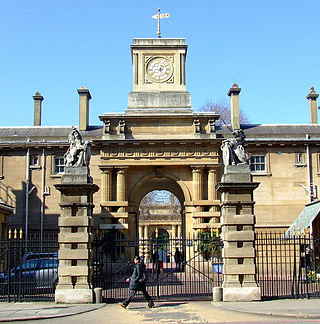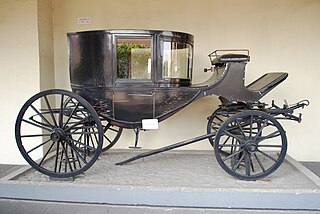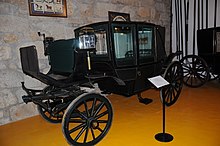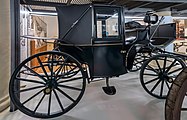
A carriage is a two- or four-wheeled horse-drawn vehicle for passengers. Second-hand private carriages were common public transport, the equivalent of modern cars used as taxis. Carriage suspensions are by leather strapping or, on those made in recent centuries, steel springs. Two-wheeled carriages are usually owner-driven.

The Royal Mews is a mews, or collection of equestrian stables, of the British royal family. In London these stables and stable-hands' quarters have occupied two main sites in turn, being located at first on the north side of Charing Cross, and then within the grounds of Buckingham Palace.

A buggy refers to a lightweight four-wheeled carriage drawn by a single horse, though occasionally by two. Amish buggies are still regularly in use on the roadways of America. The word "buggy" has become a generic term for "carriage" in America.
There are many types of car body styles. They vary depending on intended use, market position, location, and the era they were made.
The Landau began as a carriage design with a folding fabric top consisting of two sections supported by external elliptical springs. This landau roof design was adopted in early automobiles as a convertible top. The term, however, came to mean a simulated convertible. A landau bar is an ornamental feature located on a car's c-pillar derived from the roof form, primarily used on hearses.

A landaulet, also known as a landaulette, is a car body style where the rear passengers are covered by a convertible top. Often the driver is separated from the rear passengers by a division, as with a limousine.

The Irish State Coach is an enclosed, four-horse-drawn carriage used by the British Royal Family. It is the traditional horse-drawn coach in which the British monarch travels from Buckingham Palace to the Palace of Westminster to formally open the new legislative session of the UK Parliament.

A clarence is a type of carriage that was popular in the early 19th century. It is a closed, four-wheeled horse-drawn vehicle with a projecting glass front and seats for four passengers inside. The driver sat at the front, outside the carriage. The clarence was named after Prince William, Duke of Clarence and St Andrews, later King William IV of the United Kingdom, who died in 1837. It was introduced in 1840 in London. The Brougham was a lighter, two-passenger version originally commissioned by Lord Brougham.

A barouche is a large, open, four-wheeled carriage, both heavy and luxurious, drawn by two horses. It was fashionable throughout the 19th century. Its body provides seats for four passengers, two back-seat passengers vis-à-vis two behind the coachman's high box-seat. A leather roof can be raised to give back-seat passengers some protection from the weather.

A horse-drawn vehicle is a piece of equipment pulled by one or more horses. These vehicles typically have two or four wheels and were used to carry passengers or a load. They were once common worldwide, but they have mostly been replaced by automobiles and other forms of self-propelled transport but are still in use today.

A postilion or postillion is a person who guides a horse-drawn coach or post chaise while mounted on the horse or one of a pair of horses. By contrast, a coachman controls the horses from the vehicle itself.

The Musical Ride of the Royal Canadian Mounted Police is a special unit showcasing the equestrian skills performed by 32 cavalry who are regular members of the force. It holds events held in Canada and worldwide to promote the RCMP. The first official ride was held in 1887 in Regina, District of Assiniboia, and was commanded by Inspector William George Matthews.

Windsor Grey is a moniker for the grey horses used by the British monarchy to pull carriages and state coaches in ceremonial processions such as those for coronations, royal weddings, Trooping the Colour, and the opening of Parliament. They are named for Windsor Castle where they were originally stabled, though today they live at the Royal Mews near Buckingham Palace.

A coach is a large, closed, four-wheeled, passenger-carrying vehicle or carriage usually drawn by two or more horses controlled by a coachman, a postilion, or both. A coach has doors in its sides and a front and a back seat inside. The driver has a raised seat in front of the carriage to allow better vision. It is often called a box, box seat, or coach box. There are many types of coaches depending on the vehicle's purpose.

A vis-à-vis is a carriage in which the passengers sit face to face with the front passengers facing rearward and the rear passengers facing forward. The term comes from the French vis-à-vis, meaning face to face.

A brougham was originally a car body style where the driver sat outside and passengers seated within an enclosed cabin, — deriving the configuration from the earlier brougham horse-drawn carriage. Similar in style to the later town car, the brougham style was used on chauffeur-driven petrol and electric cars.

The Royal Dutch State Limousine is the former official state car of Queen Juliana of the Netherlands, based on a custom-built 1958 Rolls-Royce Silver Wraith Limousine Landaulette.

The United Kingdom's 1902 State Landau is a horse-drawn carriage with a flexible leather hoods which drop.

A coupé was a four-wheeled carriage with outside front seat for the driver and enclosed passenger seats for two persons. The name coupé comes from the French past participle of couper, "cut".

A state coach, also known as a gala coach, is a highly decorative ceremonial coach used in Europe by a monarch or head of state on state occasions. A four-wheeled vehicle for four passengers, it may be drawn at a walk by six or more horses with postilions, or be driven by two or more horses. The term is also used to indicate a formal town coach used by nobility and the wealthy for formal occasions, drawn by a pair of matching horses.



























